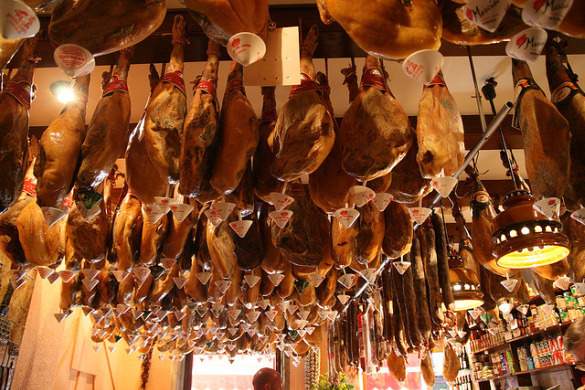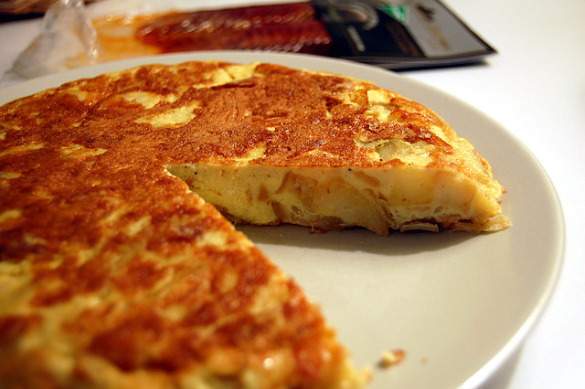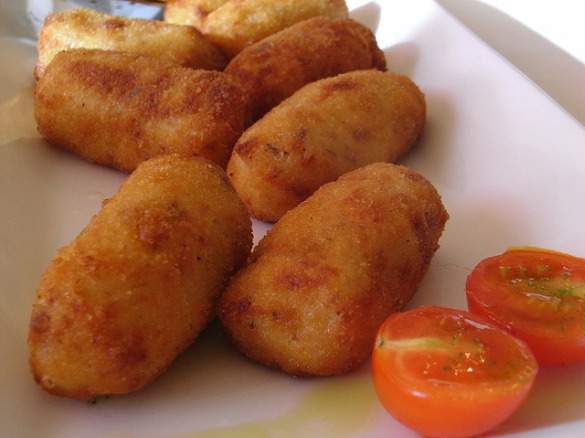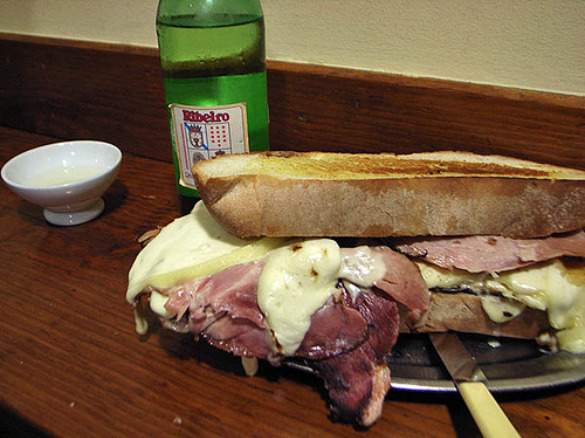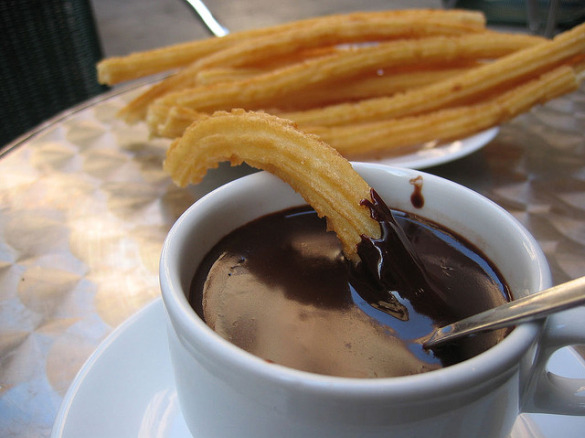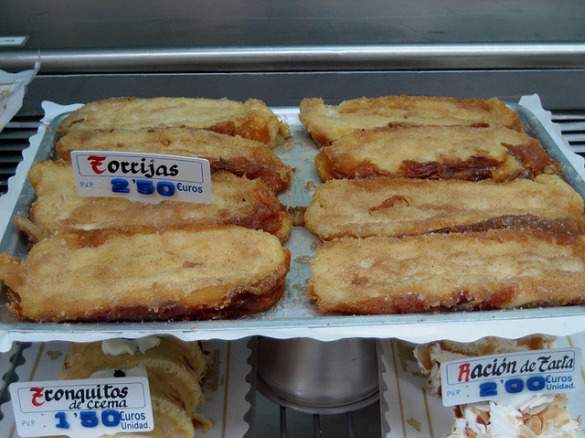Seeing the sights of Madrid is all very well and good, but as far as I’m concerned filling your stomach with good, local food is the truly memorable travel experience. Here’s my guide to what you shouldn’t leave Madrid without eating. You might want to pack something with an elasticated waistband, just in case…
Jamón
There’s a steadily growing vegetarian population in Spain, but many of them are still reported to make an exception for jamón. Cured ham is to Spain what wine is to France or pasta to Italy: it’s taken extremely seriously and you’ll quickly find yourself acting like a connoisseur once you’ve learned a thing or two about it. It’s primarily divided into two types: jamón serrano and the more expensive jamón ibérico, with jamón ibérico de Bellota, ham made from black Iberian pigs fed on acorns, being the most expensive and sought-after of the lot. The best place to try some is at the Museo del Jamón, a chain of charcuteries/cafes/restaurants. Instead of having a hurried meal at the bar, buy a few freshly cut lonchas (slices) from the butchers, take back to your hotel and savour. Combine with a baguette and you really have all the food you could need or want during your stay.
[social]
Tortilla de patatas
Containing nothing more than fried potatoes, onions and egg, this Spanish staple can be found in every neighbourhood café. I wish I could explain what makes this simple combination of ingredients so addictive, but it almost has a place as a Spanish comfort food. It is sometimes served as part of a sandwich, wedged between a white baguette, but I’d recommend it on its own, slightly warm – you’ll soon be hooked.
Gazpacho and Cocido

Two seasonal dishes – depending on what time of the year you’ll go you’re sure to find one of them on offer. Gazpacho is the more well-known, the tasty cold tomato soup served during summer months. It’s incredibly refreshing during hot weather, particularly since you’re given a tray of chopped onions, peppers, croutons and other condiments to personalize your dish to your taste.
Cocido, only available during the winter, is perhaps the most iconic dish of Madrid. Usually served on Tuesdays for reasons long-forgotten, cocido is a chickpea-based stew containing a variety of different meats, vegetables and more. It’s usually served in two parts – the caldo stew for the first course served with noodles, then the meat and chickpeas for the second course, occasionally with the vegetables served separately. It’s a fantastically filling and hearty dish for the winter months, and any café or restaurant you go to is bound to tell you that your version is the best.
Feeling particularly brave during your winter stay? Try the local delicacy of callos, a tripe-based stew made with chorizo, blood sausage, the hoof and snout of a cow and the tripe of a calf or lamb. Extremely rich and warming during the winter months, it’s perhaps not one for the vegetarians, or those with an aversion to eating the less attractive parts of animals.
Pimientos de padrón
Contrary to what you might expect, Spaniards are not especially keen on spicy dishes – even Indian restaurants in Spain are known to sweeten their curries to cope with local demand. The exception is the small green pepper known as the pimiento de padrón, which hails from the Padrón province in the north of Spain. These small green peppers are served fried and coated with coarse salt, and are deliciously morish. For the most part they are sweet and mild, but every so often you come across a rogue pepper which will burn your tongue off. This has led some people to dub eating pimientos as the Spanish Russian Roulette: as the traditional phrase goes: “unos pican y otros no”: some are hot and some are not.
Bocadillo de Calamares
Feel like you’re just not cramming quite enough carbs into your day? Try the bocadillo de calamares, a white-bread baguette filled with deep-fried squid rings. This is served in practically every café in Madrid, with various locations vying for supremacy. El Brillante café opposite Atocha station is perhaps the most famous, but there are a number of others in the Atocha area and surrounding the Plaza Mayor also worth trying.
Croquetas
Although Brits might be reminded of school lunches on seeing these deep-fried delights, the madrileño original is something completely different. Filled with gooey béchamel cheese and ham and covered in breadcrumbs, croquetas are a staple of any decent tapas bar and go fantastically well when washed down with a caña (small draught beer).
Zapatilla
A speciality of the infamous Bar Melo’s in the district of Lavapiés, eating – or attempting to eat – the zapatilla is an experience in itself. The zapatilla (meaning ‘slipper’ is an enormous toasted sandwich stuffed with melted cheese and lacón, a type of ham similar to gammon. It’s a delicious greasy delight, perfectly washed down with a cup of cider. If you manage to squeeze your way in (most people end up eating standing up, so popular is this tiny café), order a “ración” or “media-ración” of the zapatilla – a half-portion will feed 2-3, while a full sandwich will be more than enough for 6. Don’t expect to feel hungry again for the next day or so.
Churros
These long sticks of deep-fried dough are not for the faint-hearted. Served with a bowl of hot chocolate so thick you could stand your spoon in it, churros are not as sweet as many visitors expect them to be. Though you can by them dusted with sugar or filled with cream, the authentic churro is savoury and greasy. Instead of sweetness, the grease of the dough is off-set by the richness of the chocolate, leading to a calorific but deeply indulgent delight. These are often eaten by revellers early in the morning, on their way back home after a night out. To sample the best, the Chocolatería San Gines is the ultimate destination, just off the Plaza Mayor with a fantastic old-fashioned décor and a history stretching back to 1894.
More sweet treats
You can’t leave Madrid without sampling some classic Spanish pastries. Leave any concerns about your waistline behind: the Spanish specialise in delicious baked, fried and gooey items which are simply irresistible. For the absolute best, head to La Mallorquina bakery on the Puerta del Sol, also founded in 1894 (obviously a good year for Madrid cuisine).
Try the torrijas, the Spanish version of French toast usually cooked in wine, rosquillas, similar to doughnuts and available under various guises depending on the time of year, or huesos de santos around the Day of the Dead in November: marzipan shaped like bones with sweet fillings. The ultimate must-eat (though not available during summer) is turrón, a nougat-like substance available in either hard or soft forms. There are dozens of varieties available, my personal favourite being the hard Alicante variety filled with almonds, but it’s recommended you sample a few (and then a few more) to find your own favourite. Aren’t you glad you brought that stretchy waistband now?
Ready to go? Look for cheap flights to Spain, find hotels in Madrid, and learn more about what to eat in Spain.
Lindsey Ford is a food-loving London-based writer and translator. She currently blogs about Madrid hotels, restaurants, attractions and traveller’s tips for the Madrid hotel price comparison website SubwayHotels.com.
Photos by: Bernt Rostad, su-lin, Lindsey Ford, Lindsey Ford, Lindsey Ford, jlastras, lban, Sami Keinanen, Vincenzo Caico
